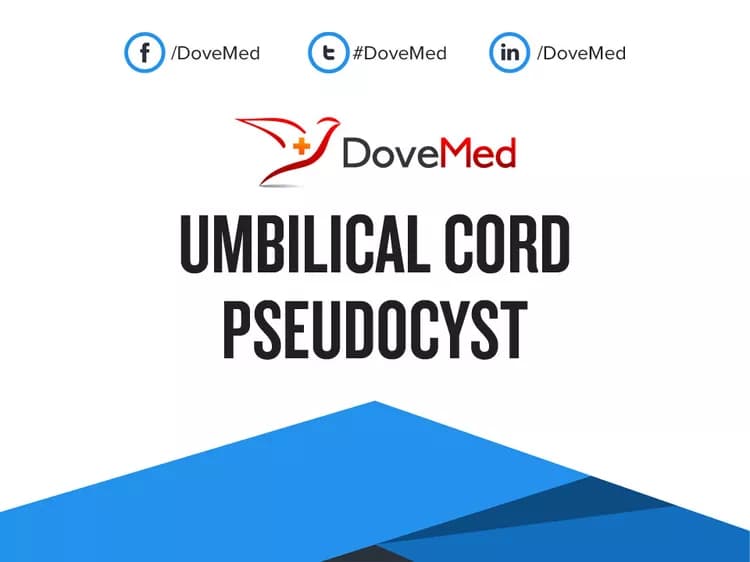What are the other Names for this Condition? (Also known as/Synonyms)
- Cystic Mucoid Degeneration of Umbilical Cord
- Giant Focal Edema of Umbilical Cord
- Wharton’s Jelly Cyst
What is Umbilical Cord Pseudocyst? (Definition/Background Information)
- Umbilical Cord Pseudocyst is a benign condition, where there is a presence of a single or multiple fluid-filled spaces within the umbilical cord
- The placenta is an organ that connects the developing fetus to the uterine wall. It is a disc shaped reddish brown structure that connects the fetus to the mother through the umbilical cord
- The umbilical cord contains two umbilical arteries and one umbilical vein, providing a connection between maternal and fetal blood circulation
- The normal function of placenta is to supply nutrients and oxygen to the fetus from the mother’s blood and remove wastes from the fetal body
- The presence of Umbilical Cord Pseudocyst is shown to be linked with increased fetal distress. However, majority of the times, there are no significant signs and symptoms or complications observed
- Umbilical Cord Pseudocyst requires no treatment and the outcome is generally excellent
Who gets Umbilical Cord Pseudocyst? (Age and Sex Distribution)
- Umbilical Cord Pseudocyst is a condition that is observed during pregnancy. It may occur in pregnant women of all ages
- Women who are pregnant with both male and female fetuses can be affected
- There is no racial, ethnic, or geographical predilection observed
What are the Risk Factors for Umbilical Cord Pseudocyst? (Predisposing Factors)
Currently, no risk factors have been identified for Umbilical Cord Pseudocyst. However, it is known to be associated with the following conditions/disorders:
- Omphalocele
- Chromosomal abnormalities such as trisomy 18
- Intrauterine growth retardation (IUGR)
- Polyhydramnios (excess fluid in amniotic sac)
It is important to note that having a risk factor does not mean that one will get the condition. A risk factor increases ones chances of getting a condition compared to an individual without the risk factors. Some risk factors are more important than others.
Also, not having a risk factor does not mean that an individual will not get the condition. It is always important to discuss the effect of risk factors with your healthcare provider.
What are the Causes of Umbilical Cord Pseudocyst? (Etiology)
- The exact cause of Umbilical Cord Pseudocyst is unknown
- Research is currently being performed to identify the relevant causative factors
It is not caused by what the expectant mother does or does not do, either prior to or during pregnancy.
What are the Signs and Symptoms of Umbilical Cord Pseudocyst?
Generally, there are no significant signs and symptoms associated with Umbilical Cord Pseudocyst, either in the pregnant mother or in the developing fetus.
How is Umbilical Cord Pseudocyst Diagnosed?
The diagnosis of Umbilical Cord Pseudocyst may involve:
- Physical examination along with an evaluation of one’s medical history
- Prenatal ultrasound scan may reveal the cyst (some cysts may be as large as 5 cm)
- The presence of a cyst on the ultrasound scan may call for other differential diagnosis such as umbilical cord hernia, allantoic duct remnant, omphalomesenteric duct remnant, and gastroschisis
- A careful examination of the placenta by a pathologist after birth of the child, to macroscopically (gross visual exam) and microscopically analyze the placental tissue may help establish a definitive diagnosis
Many clinical conditions may have similar signs and symptoms. Your healthcare provider may perform additional tests to rule out other clinical conditions to arrive at a definitive diagnosis.
What are the possible Complications of Umbilical Cord Pseudocyst?
In a majority of cases, there are no complications associated with Umbilical Cord Pseudocyst. However, sometimes, the condition may result in:
- Premature delivery
- Fetal distress
How is Umbilical Cord Pseudocyst Treated?
- Umbilical Cord Pseudocyst is a benign condition that generally requires no treatment
- In case of any complications, supportive and symptomatic treatment is provided. An elective delivery should be considered in case of significant fetal distress
How can Umbilical Cord Pseudocyst be Prevented?
- Currently, there is no effective prevention of Umbilical Cord Pseudocyst available
- However, in order to prevent significant complications, a close monitoring of the developing fetus may be recommended by the healthcare provider
What is the Prognosis of Umbilical Cord Pseudocyst? (Outcomes/Resolutions)
- In most cases, the prognosis of Umbilical Cord Pseudocyst is generally excellent, since it is a benign condition
- Typically, it does not cause any significant signs and symptoms in the developing fetus, or complications in newborn babies
Additional and Relevant Useful Information for Umbilical Cord Pseudocyst:
The following DoveMed website link is a useful resource for additional information:
https://www.dovemed.com/diseases-conditions/pregnancy-related-disorders/
Related Articles
Test Your Knowledge
Asked by users
Related Centers
Related Specialties
Related Physicians
Related Procedures
Related Resources
Join DoveHubs
and connect with fellow professionals


0 Comments
Please log in to post a comment.